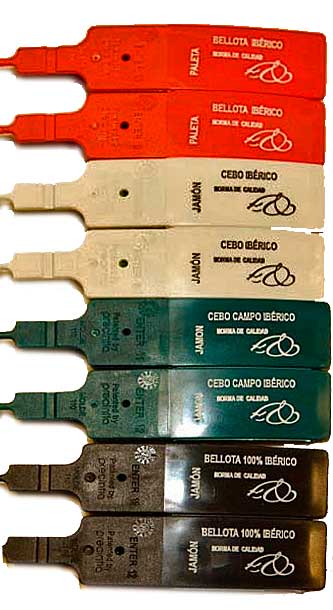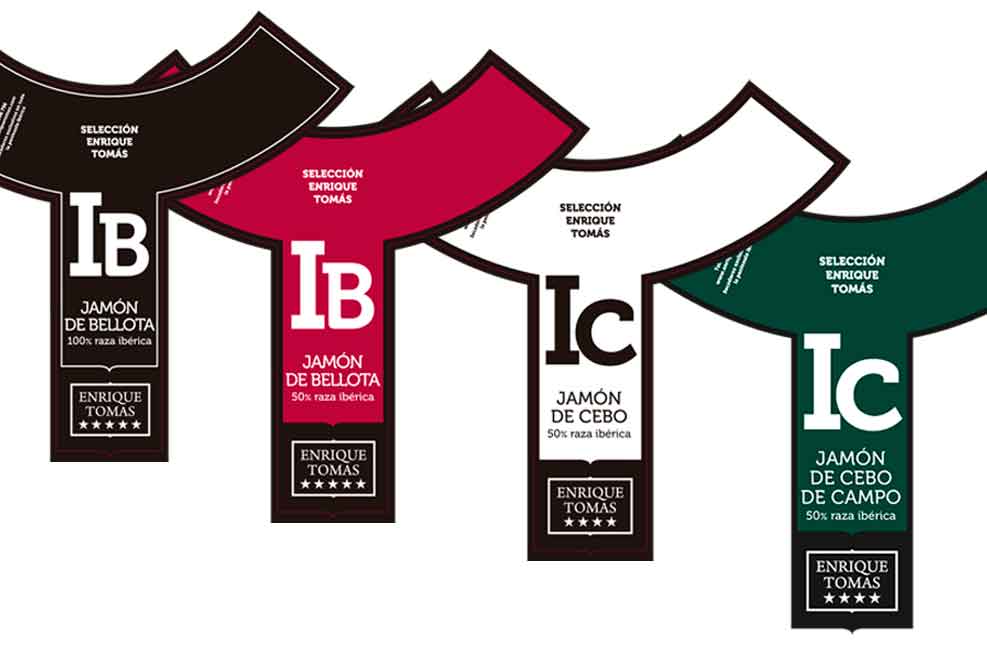
What Iberian ham to buy? Regulations, flanges and labels
When it comes to buying Iberian ham, doubts and suspicions may arise. That's why on January 10, 2014, the current Spanish regulation regarding Iberian ham was approved to prevent fraud and scams related to our most international delicacy and to protect the purity of the breed of our Iberian pigs.
To simplify the regulation, a color-coded system of tags and labels for Iberian ham was introduced, making it easier to understand. If you want to know it and avoid being fooled... there's no one better than Enrique Tomás to explain it to you!
How the Color-Coded System of Tags and Labels for Iberian Ham Works
Let's start from the beginning. Iberian pigs are those descended from at least one parent 100% Iberian - usually the mother - and have the ability to infiltrate fat into the muscle. This genetic factor makes their meat juicier and distinguishes them as a unique breed in the world.
That said, according to the 2014 regulation, Iberian hams can be:
- Bellota 100% Iberian
- Bellota 75% Iberian
- Bellota 50% Iberian
- Cebo de Campo 100% Iberian
- Cebo de Campo 75% Iberian
- Cebo de Campo 50%
- Cebo 100% Iberian
- Cebo 75% Iberian
- Cebo 50% Iberian

However, when it comes to labeling them with color-coded tags or seals, four major groups are used to simplify this categorization:
- Black Tag: Used only for 100% Iberian acorn-fed ham, commonly known as "pata negra," which comes from 100% Iberian pigs raised in the pasturelands (dehesas).
- Red Tag: This seal identifies acorn-fed Iberian ham that comes from pigs crossbred with Duroc Yersey and raised in the pasturelands, that is, they are fed with acorns. The difference from the black-tag hams is that in this case, the purity of the Iberian breed is only 75% or 50%.
- Green Tag: This color is for pigs raised on natural grass, herbs, and feed, what we now call Cebo de Campo. In other words, although it's an Iberian pig (whether 100%, 75%, or 50%), it hasn't been fed acorns during the fattening period.
- White Tag: These are the Iberian hams from pigs fed with compound feed made from grains and legumes and raised in intensive systems. Similar to green-tag hams, white-tag hams can have any percentage of breed purity, but in this case, the exclusive diet has been composed of feed.
When buying top-quality Iberian ham, all you need to do is look at the four colors and read the label to see what type of ham you're dealing with. Terms like "reserve," "nobility," "superior," etc., don't matter. ONLY pay attention to the color of the label and the information about breed purity it contains.

What Else to Know About Ham Labeling
To better clarify the labeling system, at Enrique Tomás, we want to explain a series of aspects highlighted by the current regulation. First, the term "cebo de campo" is what was previously known as "recebo," and the concept of "pata negra" can only be used when referring to 100% acorn-fed Iberian ham, which is considered the highest quality.
- Regarding breed purity, as mentioned before, for Iberian ham to be considered as such, it must have at least one parent that is 100% Iberian, usually the mother.
- 50% hams come from pigs 100% crossed with white pigs.
- Hams will be 75% Iberian breed when the mother is 100% Iberian and the father is 50% Iberian.
- Hams will be 100% pure breed when obtained from a pig whose father and mother are both 100% Iberian.
Lastly, let's talk about the age that pigs must reach before being slaughtered. The minimum age required for acorn-fed Iberian pigs is 14 months, for pasture-raised Iberian pigs, it's twelve months, and for feed-fed Iberian pigs, they can be slaughtered at a younger age, around ten months.
Remember that any label can apply various adjectives to the product, words like "premium," "nobility," "superior," or "top quality" are frequently found on hams, but the only information that matters for identifying the quality of a product like our ham is the breed purity percentage and the type of feeding received during the final fattening phase.

As you can see, to avoid falling into any ham-related scams, all you need is to have all the necessary information about the color-coded tags and labels for Iberian ham, also known as seals.
You can also follow one of our great tips: when buying Iberian ham, always go to your trusted specialized store or exclusive shops like any of the Enrique Tomás ham stores.
If you want to learn more about this, don't hesitate to thoroughly explore the third section of the book ''Jamón para Dummies'', where we delve deep into the origin and regulations of ham. Now we know that before buying acorn-fed ham, you should make sure of the tags and labeling. If you want to be a hundred percent sure about the quality of your cured ham, visit a specialized store like Enrique Tomás.
As true lovers of ham and the culture surrounding it, we'll only offer you top-quality Iberian ham!





